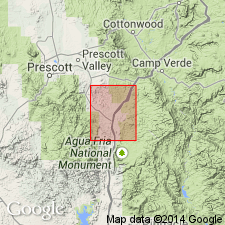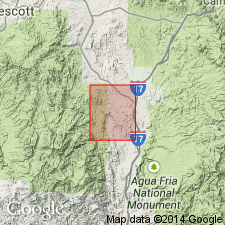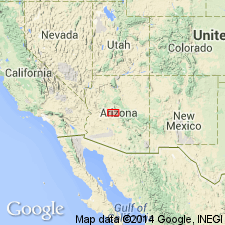
- Usage in publication:
-
- Badger Spring Granodiorite*
- Modifications:
-
- Original reference
- Adopted
- Dominant lithology:
-
- Granodiorite
- AAPG geologic province:
-
- Southwestern Basin-and-Range region
Summary:
Badger Spring Granodiorite. Consists of granodiorite that has an abundance of rounded quartz grains ranging from 3 to 12 mm diameter and averaging about 8 mm. Associated with saussuritized plagioclase crystals. Biotite dominant mafic mineral, forming scattered shredded-looking aggregates separating the quartz and plagioclase, and associated with some K-feldspar. Leucocratic facies present in southeast part of quadrangle. Age is Precambrian. Is older than Crazy Basin Quartz Monzonite (new) and younger than Bumblebee Granodiorite (new).
Named for exposures in Badger Spring Wash, in T. 10 and 11 N., R. 3 E., in southeast quarter of Mayer quadrangle, Yavapai Co., central AZ.
Source: Changes in stratigraphic nomenclature, 1973 (USGS Bull. 1395-A, p. A4-A5); GNU records (USGS DDS-6; Denver GNULEX).

- Usage in publication:
-
- Badger Spring Granodiorite*
- Modifications:
-
- Original reference
- Adopted
- AAPG geologic province:
-
- Basin-and-Range province
Summary:
Pg. 22-24. Badger Spring Granodiorite. Is the dominant granitic rock exposed south of Cordes, consisting primarily of coarse-grained granodiorite. Is foliated and crushed along the eastern margin of the Shylock fault zone. The prophyritic facies forming plugs and dikes contains conspicuous quartz and saussuritized plagioclase phenocrysts embedded in a microcrystalline groundmass of quartz and feldspar in which K-feldspar is revealed in some samples by staining. Chlorite after biotite is present, as well as the epidote and clinozoisite so conspicuous in the coarse-grained facies. Locally, micrographic intergrowths of quartz and feldspar appear. Is intrusive into the Bumblebee Granodiorite and Spud Mountain Volcanics of the Big Bug Group; underlies the Hickey Formation (in part). Age is Precambrian. (Badger Spring Granodiorite adopted by the USGS.)
Type locality: Badger Spring Wash, east of Cordes, Bradshaw Mountains, in T. 10 and 11 N., R. 3 E., in southeast quarter of Mayer quadrangle, Yavapai Co., central AZ.
Source: US geologic names lexicon (USGS Bull. 1520, p. 15-16); GNU records (USGS DDS-6; Menlo GNULEX).

- Usage in publication:
-
- Badger Spring Granodiorite*
- Modifications:
-
- Age modified
- AAPG geologic province:
-
- Southwestern Basin-and-Range region
Summary:
Assigned to suite three (of 4) in the Prescott area (Yavapai County, Arizona, Southwestern Basin-and-Range region). Suite three, consisting of pre- to late-tectonic, equigranular to porphyritic, medium- to coarse-grained biotite-hornblende granodiorite plutons, includes the 1,720 Ma quartz diorite at Bland, Bumblebee Granodiorite, and Badger Spring Granodiorite. The plutons are metaluminous, have low magnetite concentrations, low rubidium, zirconium, lanthanum, and cerium, and very low strontium, and are restricted to the southeastern part of the area. Badger Spring intrudes Bumblebee Granodiorite. Age is refined from Precambrian to Early Proterozoic. Report includes geochemical analyses.
Source: Modified from GNU records (USGS DDS-6; Denver GNULEX).
For more information, please contact Nancy Stamm, Geologic Names Committee Secretary.
Asterisk (*) indicates published by U.S. Geological Survey authors.
"No current usage" (†) implies that a name has been abandoned or has fallen into disuse. Former usage and, if known, replacement name given in parentheses ( ).
Slash (/) indicates name conflicts with nomenclatural guidelines (CSN, 1933; ACSN, 1961, 1970; NACSN, 1983, 2005, 2021). May be explained within brackets ([ ]).

